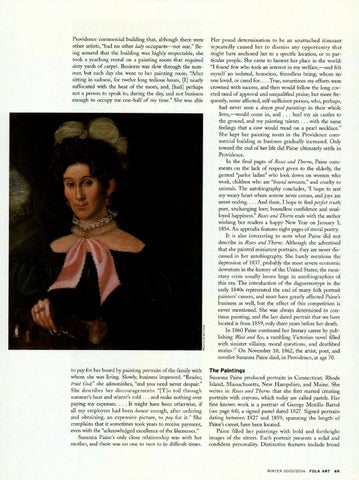MELVILLE MCLEAN
Providence commercial building that, although there were other artists,"had no other lady occupants—not one." Being assured that the building was highly respectable, she took a yearlong rental on a painting room that required sixty yards of carpet. Business was slow through the summer, but each day she went to her painting room. "After sitting in sadness, for twelve long tedious hours,[I] nearly suffocated with the heat of the room, and,[had] perhaps not a person to speak to, during the day, and not business enough to occupy me one-half of my time." She was able
Her proud determination to be an unattached itinerant repeatedly caused her to dismiss any opportunity that might have anchored her to a specific location, or to particular people. She came to lament her place in the world: "I found few who took an interest in my welfare,—and felt myself an isolated, homeless, friendless being; whom no one loved, or cared for....True,sometimes my efforts were crowned with success, and then would follow the long coveted need of approval and unqualified praise; but more frequently, some affected, self-sufficient person, who, perhaps, had never seen a dozen good paintings in their whole lives,—would come in, and... hurl my air castles to the ground, and my painting talents ... with the same feelings that a cow would tread on a pearl necklace." She kept her painting room in the Providence commercial building as business gradually increased. Only toward the end of her life did Paine ultimately settle in Providence. In the final pages of Roses and Thorns, Paine comments on the lack of respect given to the elderly, the genteel "parlor ladies" who look down on women who work, children who are "bound servants," and cruelty to animals. The autobiography concludes,"I hope to rest my weary heart where sorrow never comes, and joys are never ending.... And there,I hope to find perfect truth; pure, unchanging love; boundless confidence and unalloyed happiness." Roses and Thorns ends with the author wishing her readers a happy New Year on January 1, 1854. An appendix features eight pages of moral poetry It is also interesting to note what Paine did not describe in Roses and Thorns. Although she advertised that she painted miniature portraits, they are never discussed in her autobiography. She barely mentions the depression of 1837, probably the most severe economic downturn in the history ofthe United States; the monetary crisis usually looms large in autobiographies of this era. The introduction of the daguerreotype in the early 1840s represented the end of many folk portrait painters' careers, and must have greatly affected Paine's business as well, but the effect of this competition is never mentioned. She was always determined to continue painting, and the last dated portrait that we have located is from 1859,only three years before her death. In 1860 Paine continued her literary career by publishing Wait and See, a rambling Victorian novel filled with sinister villainy, moral questions, and deathbed stories." On November 10, 1862, the artist, poet, and novelist Susanna Paine died,in Providence, at age 70.
to pay for her board by painting portraits ofthe family with The Paintings whom she was living. Slowly, business improved."Reader, Susanna Paine produced portraits in Connecticut, Rhode trust God," she admonishes,"and you need never despair." Island, Massachusetts, New Hampshire, and Maine. She She describes her discouragements: "[T]o toil through writes in Roses and Thorns that she first started creating summer's heat and winter's cold ... and make nothing over portraits with crayons, which today are called pastels. Her paying my expenses.. .. It might have been otherwise, if first known work is a portrait of George Morillo Bartol all my employers had been honest enough, after ordering (see page 64), a signed pastel dated 1827. Signed portraits and obtaining, an expensive picture, to pay for it." She dating between 1827 and 1859, spanning the length of complains that it sometimes took years to receive payment, Paine's career, have been located. even with the "acknowledged excellence ofthe likenesses." Paine filled her paintings with bold and forthright Susanna Paine's only close relationship was with her images of the sitters. Each portrait presents a solid and mother, and there was no one to turn to in difficult times. confident personality Distinctive features include broad
WINTER 2005/2006
FOLK ART
69
